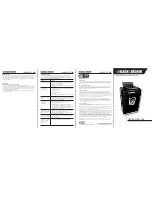
RAISED PANELS
All of our panel knives are designed to produce a ¼” tongue. Be sure to select a panel knife based on the
finished panel thickness.
A panel must be 9” or more in the direction you are moulding
in order to not have
the panel come off of one roller before it engages the second roller.
When you use
multiple passes
you
must
have at least 9” of panel remaining
in the direction of the cut in order to have a least one roller on the panel at
all times.
If you desire a different tongue size or have a panel thickness other than ¾” or 5/8,” a special knife can be
ordered and shipped quickly by W&H.
THE RAISED PANEL SET UP
1.
Disconnect the power supply.
2.
Install your knives over toward the tube side of the machine allowing enough room to install your guide.
3.
Index the knife arbor so the profile will be seen against the bed. Raise the head to allow the panel to be
laid on the bed and to be lined up with the profile visually.
4.
Once you have found the proper position for the panel, lower the head so the rollers will put pressure on
the panel while butting the guide against the panel. Tighten your guide.
5.
Raise the head, pull the panel out of the machine, and lower the head to within 3/16”of the panel height.
Rotate the blade arbor by hand to insure nothing is interfering with its rotational path.
6.
Mould the panel cross grain ends first. Stand somewhere between the open side and in-feed side.
RAISED PANEL ISSUES
It takes some practice to make a good panel. It is helpful to keep a slight upward pressure on the panel as it is
being moulded with a steady pressure against the guide.
Because panels are normally larger than the 7” cutting capacity of the machine, the panel must pass beneath the
open side of the head. There is approximately 1/32” clearance between the top of the panel and the head of the
machine, provided the head is at stock size setting, and not below.
Many users try to create a slightly deeper cut to modify the tongue size or change the profile appearance and
end up dragging and pivoting the panel away from the guide path. The head must be set at the panel thickness
and not below it in order to have clearance to pass the panel through the machine in a satisfactory way.
HOW TO PLANE
CAUTION!
When you use the machine as a planer you will need to back off all four pressure screws ¼” so
that you will not have too much roller tension, or you will risk shearing a pin in the large bronze worm gear.
Measure the thickness of your stock.
The amount of stock that is removable in one pass is dependent on the density of the wood (relative hardness),
how wide the cut is, and the moisture content of the stock.
9




































